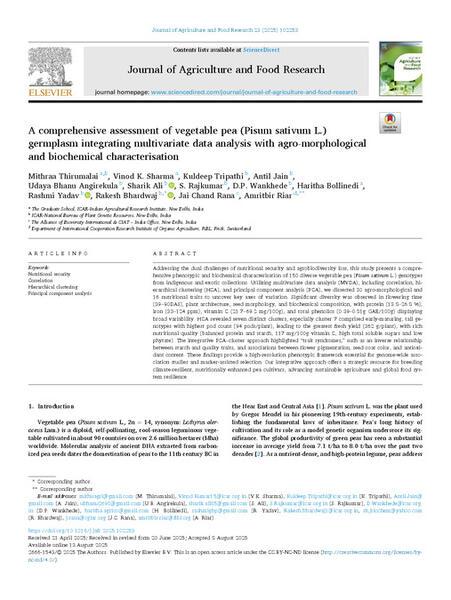Addressing the dual challenges of nutritional security and agrobiodiversity loss, this study presents a comprehensive phenotypic and biochemical characterisation of 150 diverse vegetable pea (Pisum sativum L.) genotypes from indigenous and exotic collections. Utilizing multivariate data analysis (MVDA), including correlation, hierarchical clustering (HCA), and principal component analysis (PCA), we dissected 30 agro-morphological and 16 nutritional traits to uncover key axes of variation. Significant diversity was observed in flowering time (39–90DAS), plant architecture, seed morphology, and biochemical composition, with protein (13.8–26.8 %), iron (33–124 ppm), vitamin C (21.7–69.2 mg/100g), and total phenolics (0.39–0.81g GAE/100g) displaying broad variability. HCA revealed seven distinct clusters, especially cluster 7 comprised early-maturing, tall genotypes with highest pod count (94 pods/plant), leading to the greatest fresh yield (362 g/plant), with rich nutritional quality (balanced protein and starch, 117 mg/100g vitamin C, high total soluble sugars and low phytate). The integrative PCA–cluster approach highlighted “trait syndromes,” such as an inverse relationship between starch and quality traits, and associations between flower pigmentation, seed coat color, and antioxidant content. These findings provide a high-resolution phenotypic framework essential for genome-wide association studies and marker-assisted selection. Our integrative approach offers a strategic resource for breeding climate-resilient, nutritionally enhanced pea cultivars, advancing sustainable agriculture and global food system resilience.
Thirumalai, M.; Sharma, V.K.; Tripathi, K.; Jain, A.; Angirekula, U.B.; Ali, S.; Rajkumar, S.; Wankhede, D.P.; Bollinedi, H.; Yadav, R.; Bhardwaj, R.; Rana, J.C.; Riar, A.

